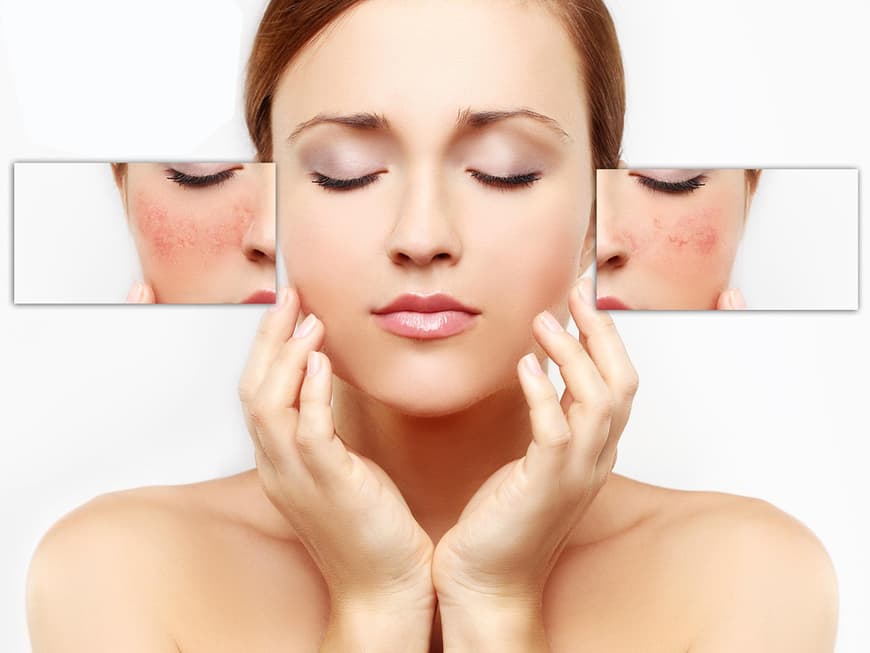Is rosacea limited to a certain skin type or can anyone suffer from it?
Anna Tersteeg:The causes of rosacea are very complex and are still being researched today. In principle, anyone can develop rosacea. However, it is also clear that genetics play an important role. The sensitive tendency of the skin to react to internal or external factors with facial redness is often inherited by those affected. The risk is therefore increased if there are already rosacea sufferers in the family. People with very fair skin are also more likely to be affected by the skin condition. It is also important to know that rosacea is not a contagious skin disease.
Individual symptoms can occur with both rosacea and acne. How can the skin problems be distinguished?
Anna Tersteeg:Acne is a disease of the sebaceous glands. Three factors can be held responsible for the development of acne: Firstly, sebaceous gland activity is increased. The skin is oily, coarse-pored and shiny. Secondly, there is an increased production of horny cells, hyperkeratosis forms, which blocks the sebaceous gland duct and thus retains the sebum in the gland, creating a blackhead (med. comedo). A third factor is the multiplication of a bacterium. The propionibacterium multiplies especially under oxygen deficiency, feels particularly comfortable in the blocked sebaceous gland and promotes inflammation of the sebaceous gland. This is how the blackhead develops into an inflammatory skin blister (pustule or papule).
Rosacea is a chronic skin disease that mainly manifests itself in the center of the face. The cause of the skin disease is the increased release of an antimicrobial peptide, a type of antibiotic produced by the skin, which triggers an inflammatory cascade in the skin. The disease is characterized by dilated veins (med. telangiectasia), redness and, in the later stages, the appearance of inflammatory skin blisters such as papules and pustules. In contrast to acne, however, no comedones appear in rosacea.
In addition, rosacea can lead to attacks of redness, known as flushing. These are triggered by various factors and only last a few minutes, but gradually lead to damage to the skin and sensitive blood vessels.
Why can rosacea worsen in summer in particular?
Anna Tersteeg:The sun is considered a trigger factor for rosacea. The heat generated by the sun stimulates the blood vessels. These dilate so that increased redness is visible. In addition, the UV-A and UV-B rays promote inflammatory processes in the skin and the formation of new blood vessels is also encouraged.
What other triggers are there?
Anna Tersteeg: In terms of triggers, a distinction can be made between endogenous, i.e. internal factors, and exogenous (external) factors. The latter lead to a deterioration in the appearance of the skin and can also cause attacks of redness. Long-term physical or psychological stress are endogenous factors that can lead to a deterioration in the skin's appearance. In addition, exogenous factors such as the change between cold and heat, alcohol or even hot spices can have an influence. Which factor you react to varies greatly from person to person.
How can the unsightly skin symptoms of rosacea be reduced with skin care products?
Anna Tersteeg:When cleansing, you should use pH-regulating products. Using a facial toner with an acidic pH value completes the cleansing process and stabilizes the skin's protective acid mantle. Rosacea care should consist of light, low-fat formulations that do not burden the skin. Gel creams also have a slightly cooling effect and are particularly pleasant for reddened, overheated facial skin. In addition, plant-based active ingredients such as horse chestnut can strengthen the blood vessels and thus protect against redness. Anti-inflammatory and soothing substances such as panthenol are also suitable for the care of irritated skin. In addition, the use of products containing fruit acids as night care can promote the regeneration of the skin. The creams often contain a combination of fruit acids. Salicylic acid is known for its anti-inflammatory and exfoliating effect. It serves as a precursor for glycolic acid. This stimulates the cell division rate and strengthens the structures of the skin. To counteract the negative effects of the sun, consistent sun protection is particularly important, not only in the sunny season. UV-A and UV-B broad spectrum protection is suitable here.
Depending on the severity of the rosacea, medical therapy may be necessary. In this case, skin care is an important support for stabilizing and regenerating the skin's appearance.
Are there any rosacea myths that persist?
Anna Tersteeg:Yes, there definitely are. The myth that rosacea is an adult acne is false. Both diseases differ both in their clinical picture and in their causes. The typical acne skin blister, the comedo, does not occur in rosacea. The two dermatoses (skin diseases) can also be distinguished from each other in terms of their triggers.
The bulbous nose that appears in the advanced stage is often associated with increased alcohol consumption. This myth is also false. The cause of the enlarged nose is a proliferation of the sebaceous glands and the surrounding tissue.



